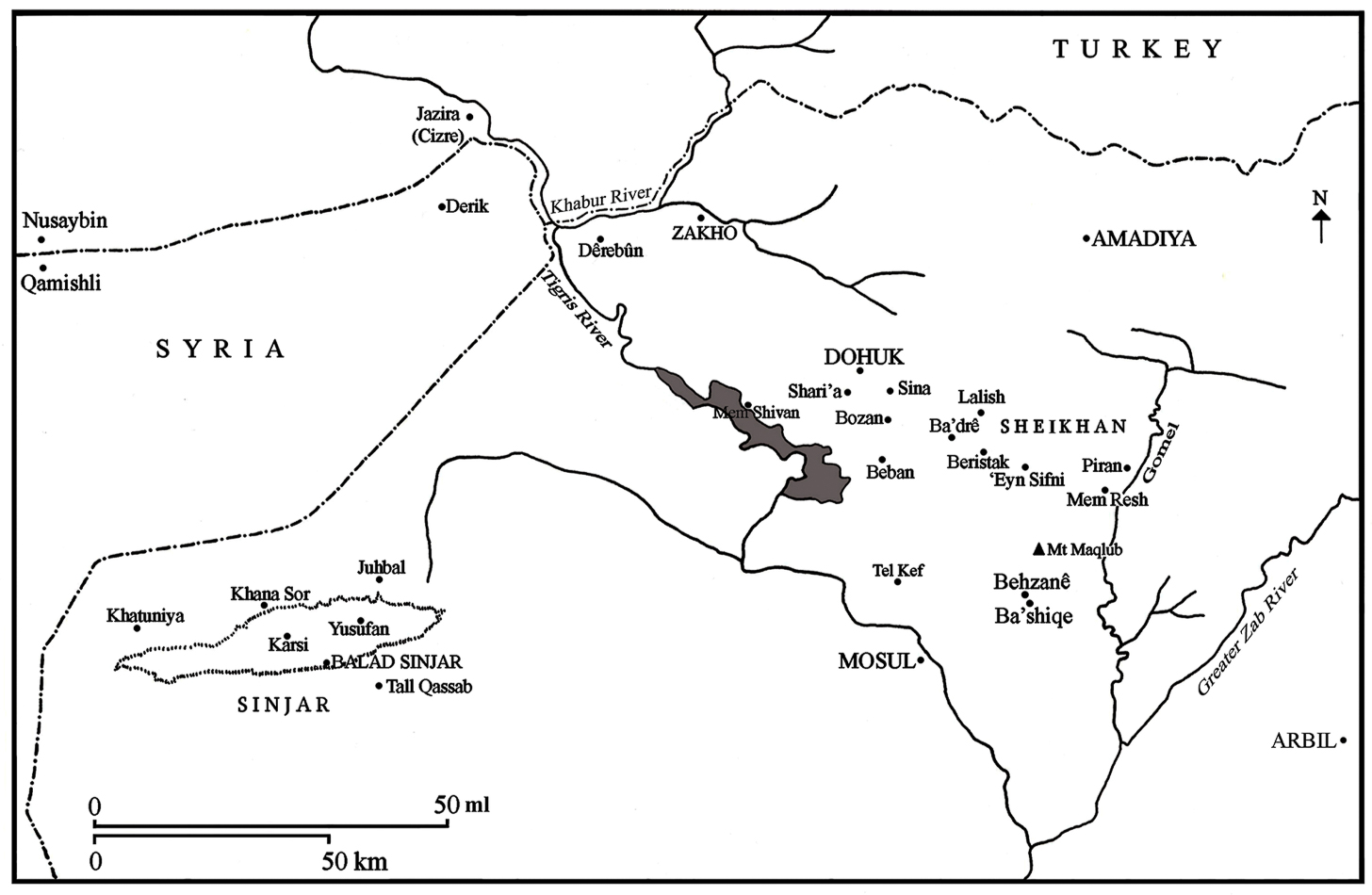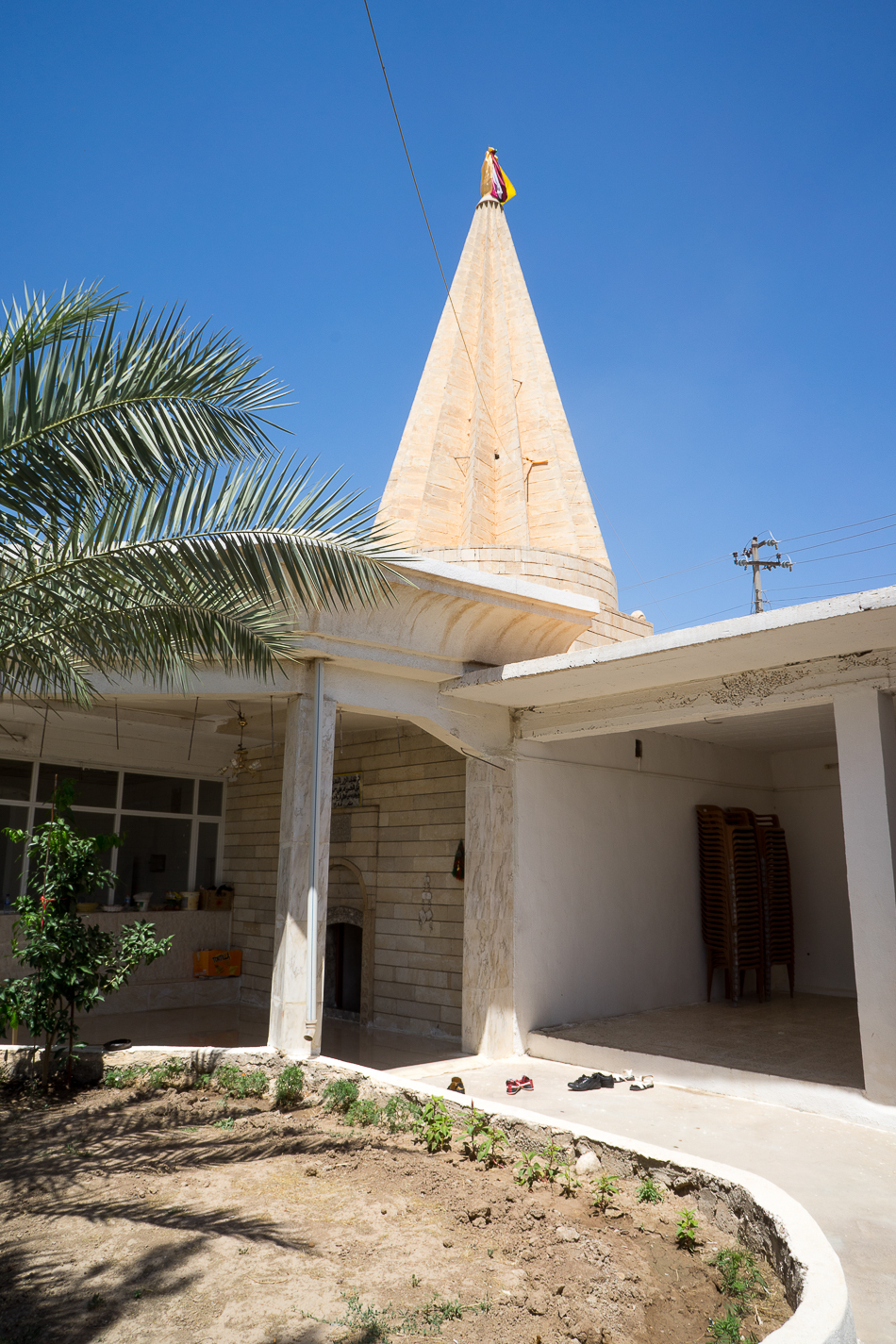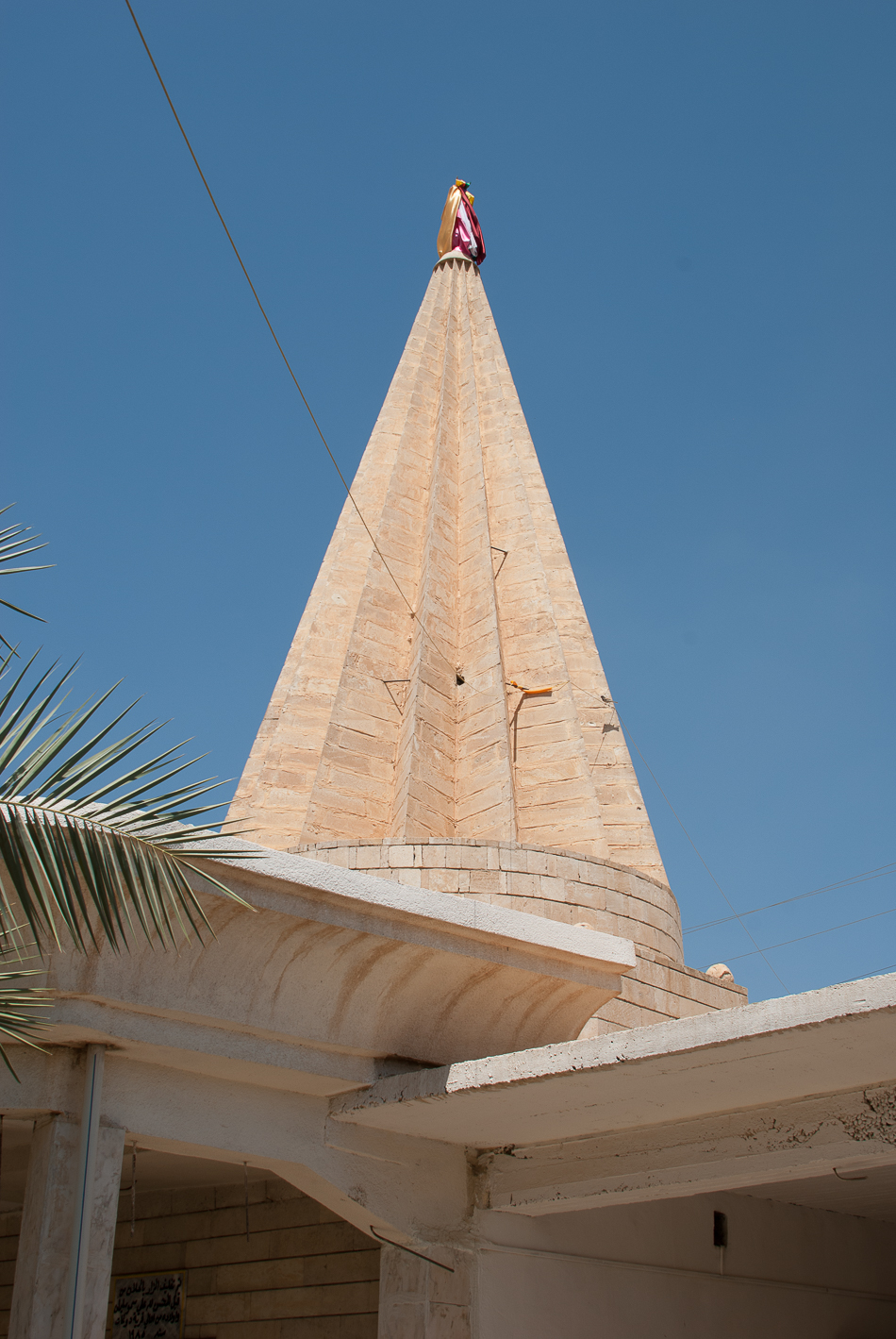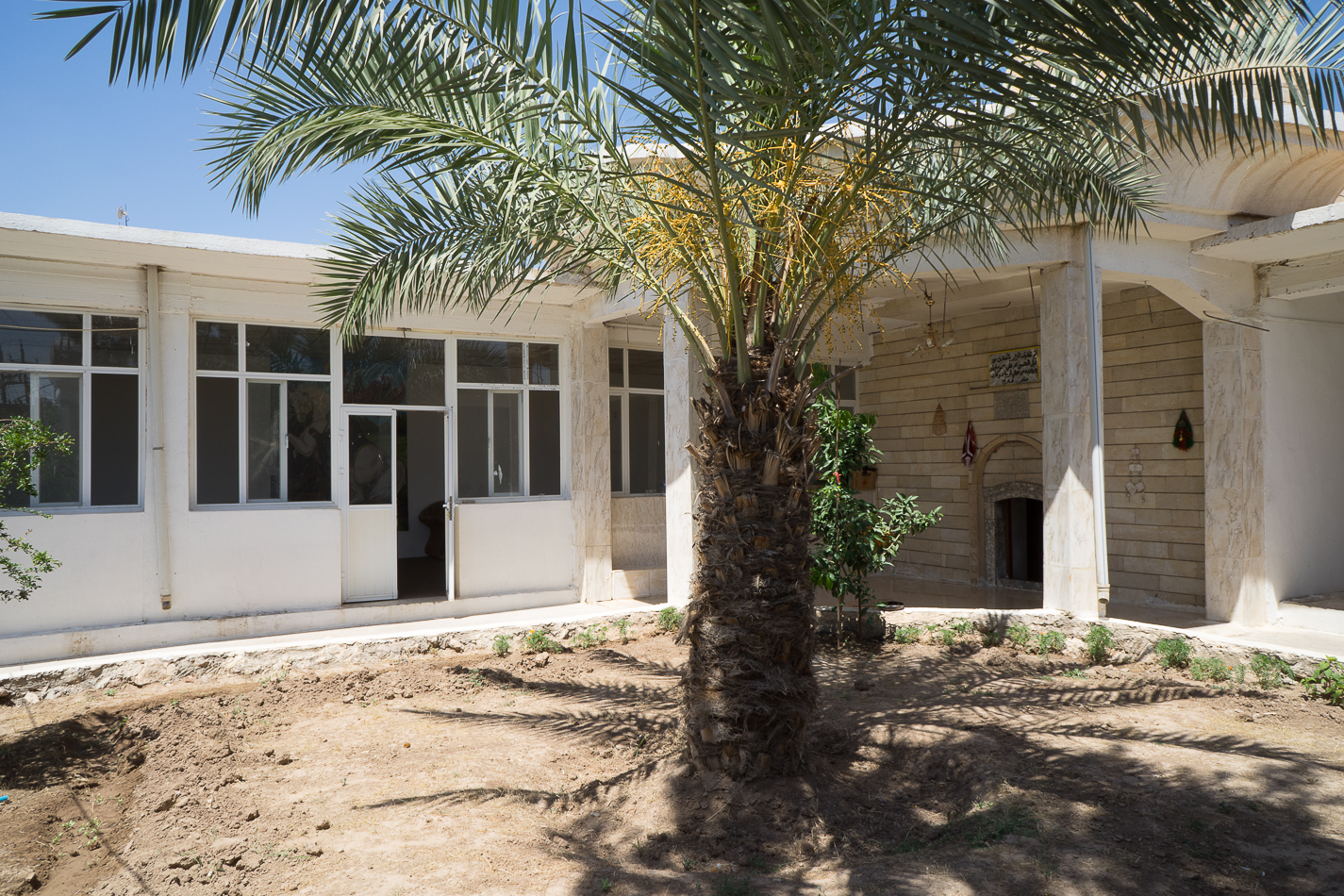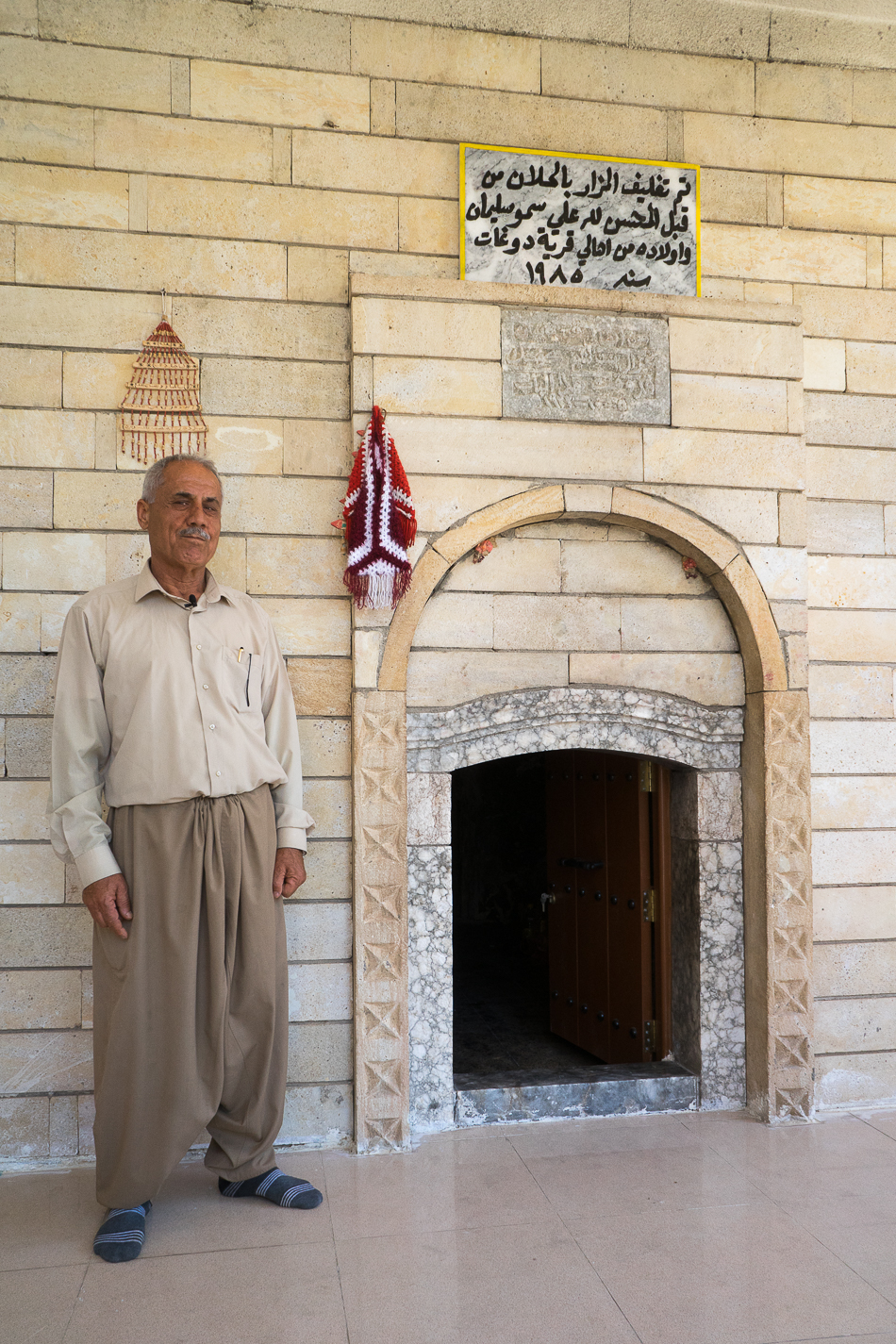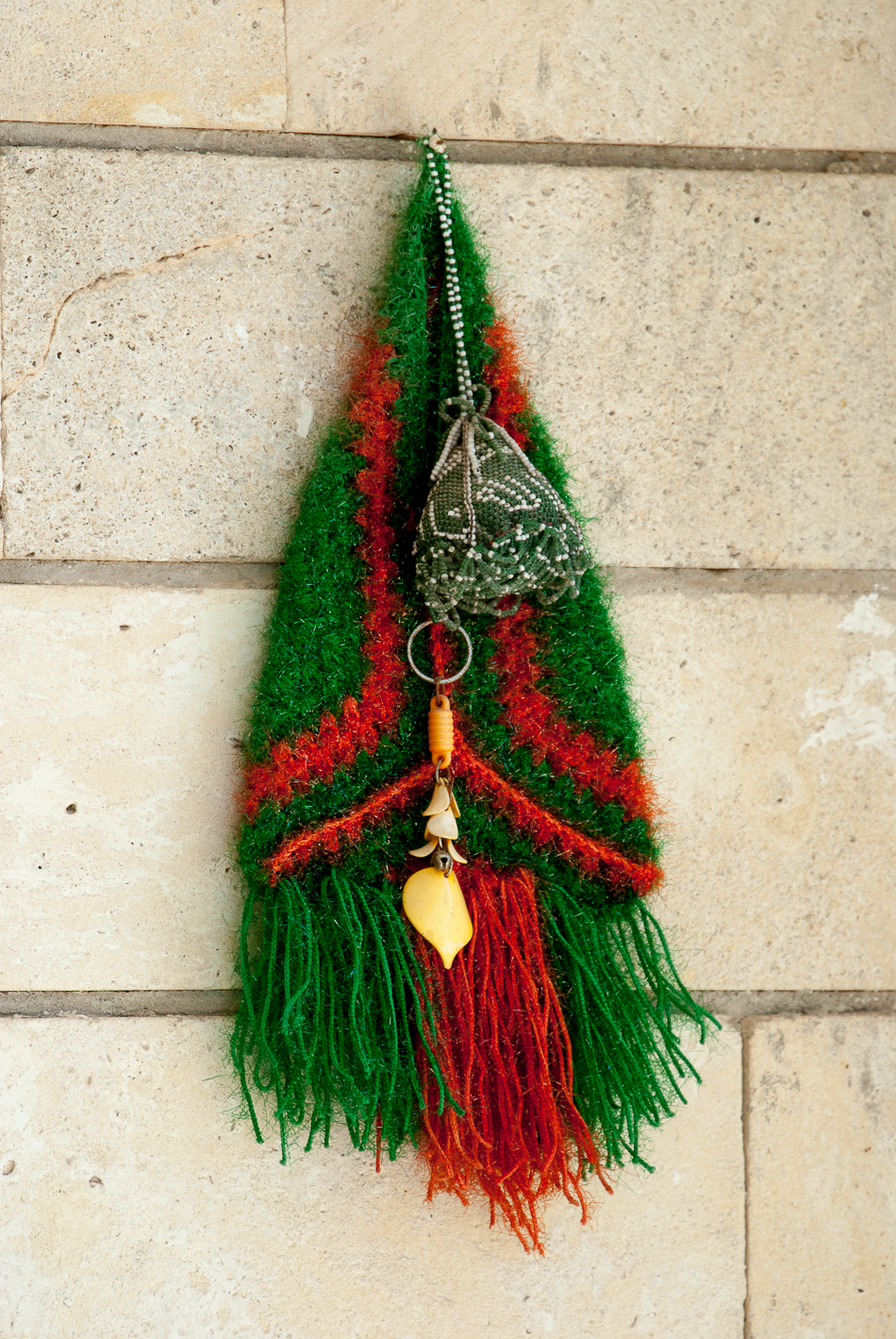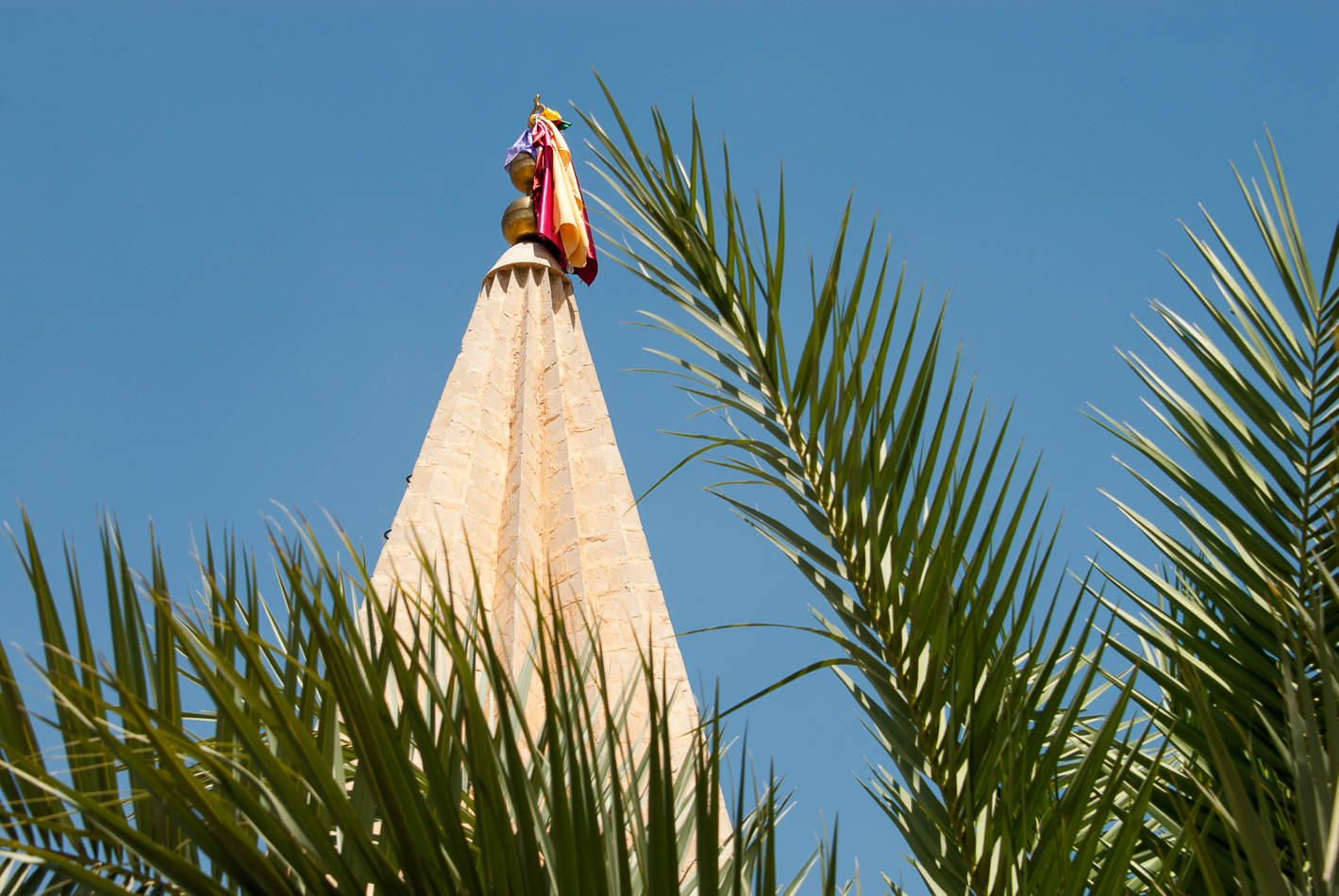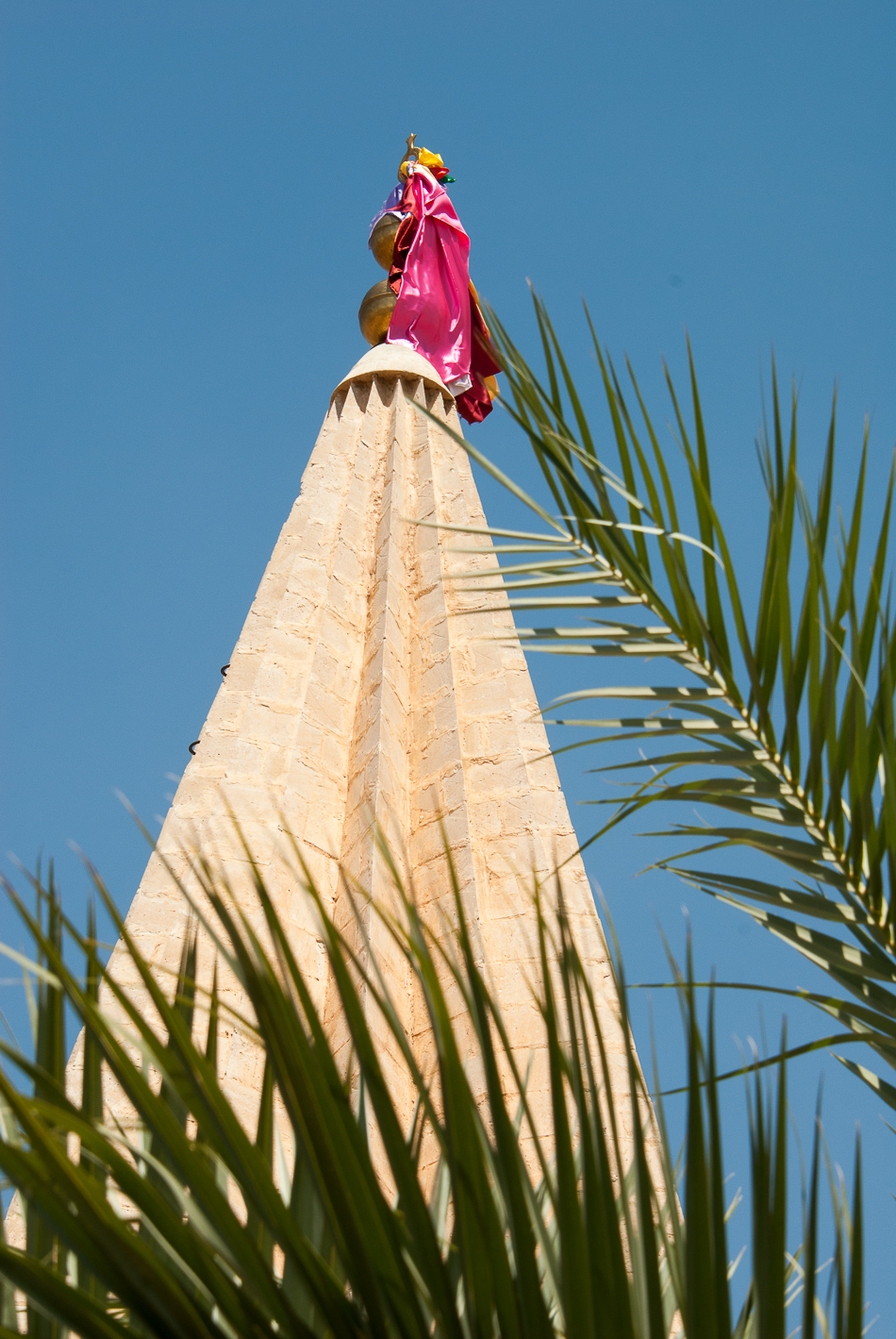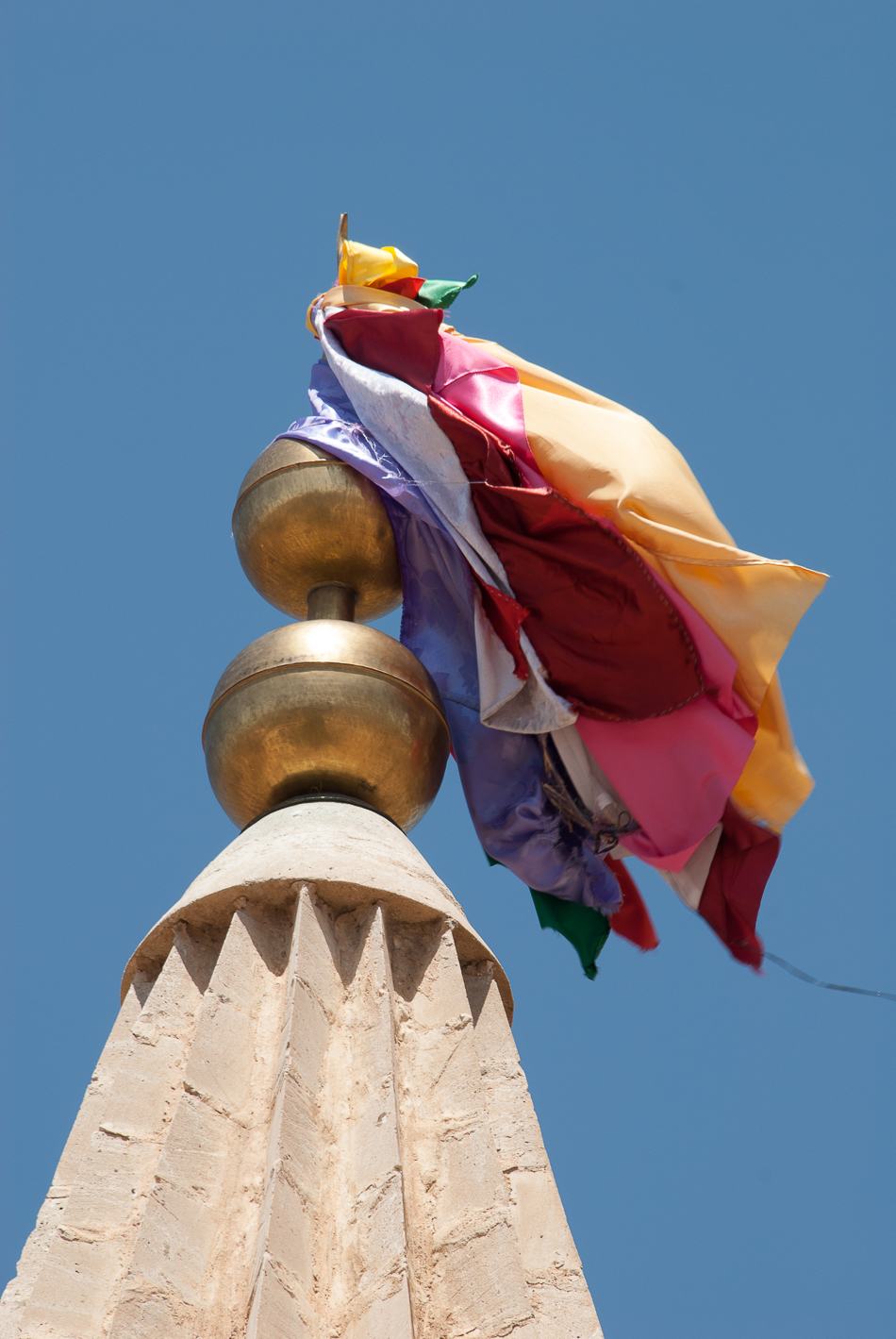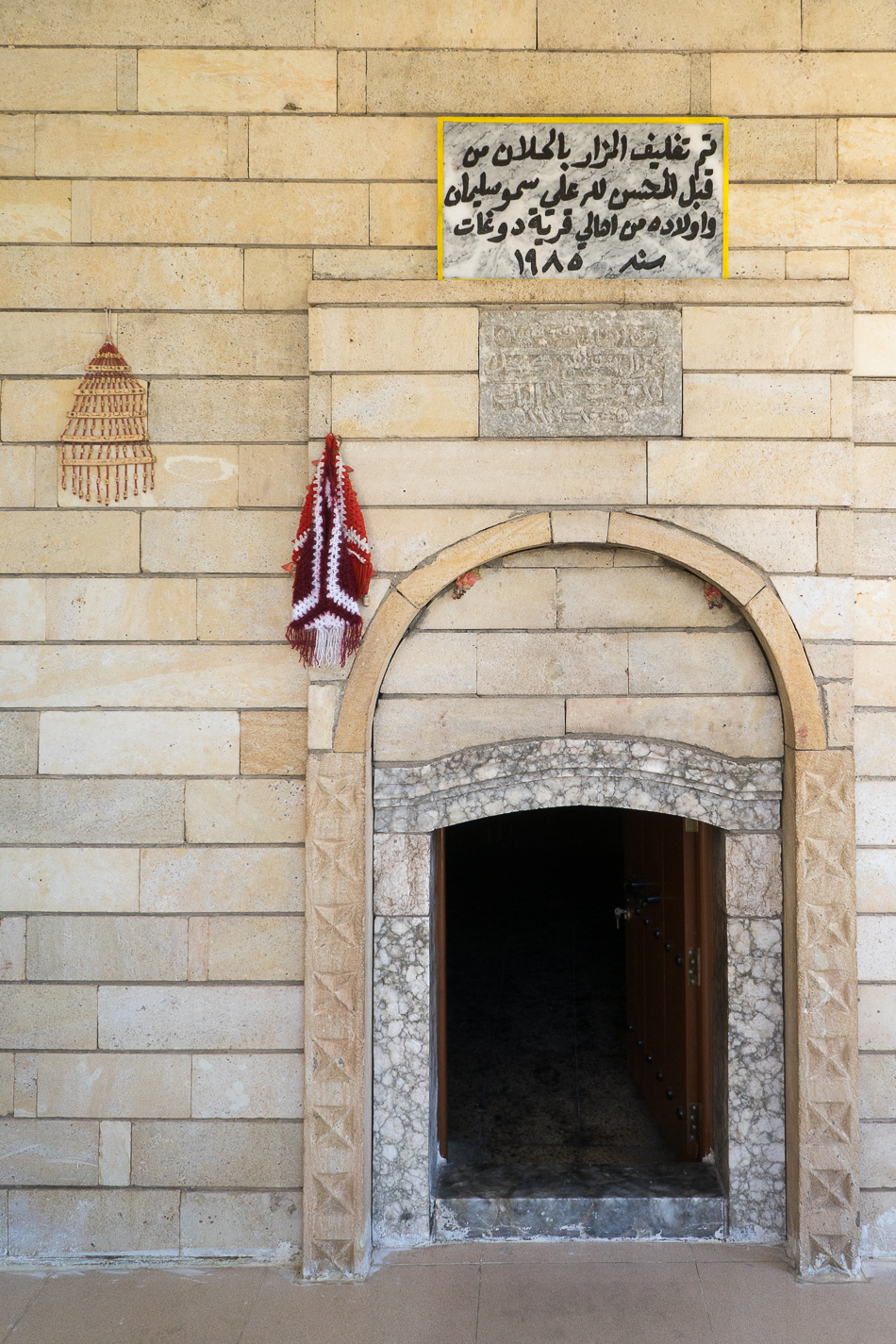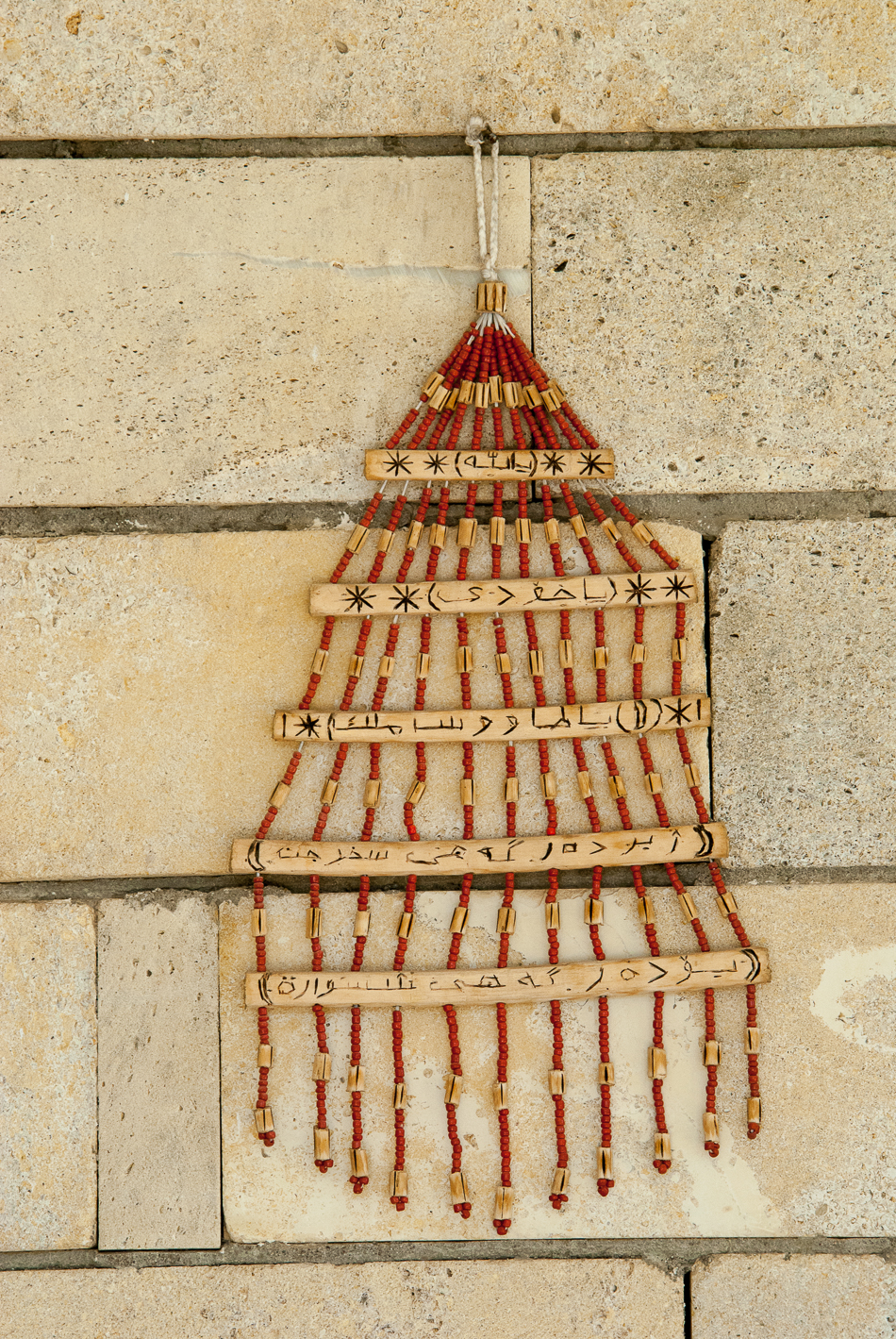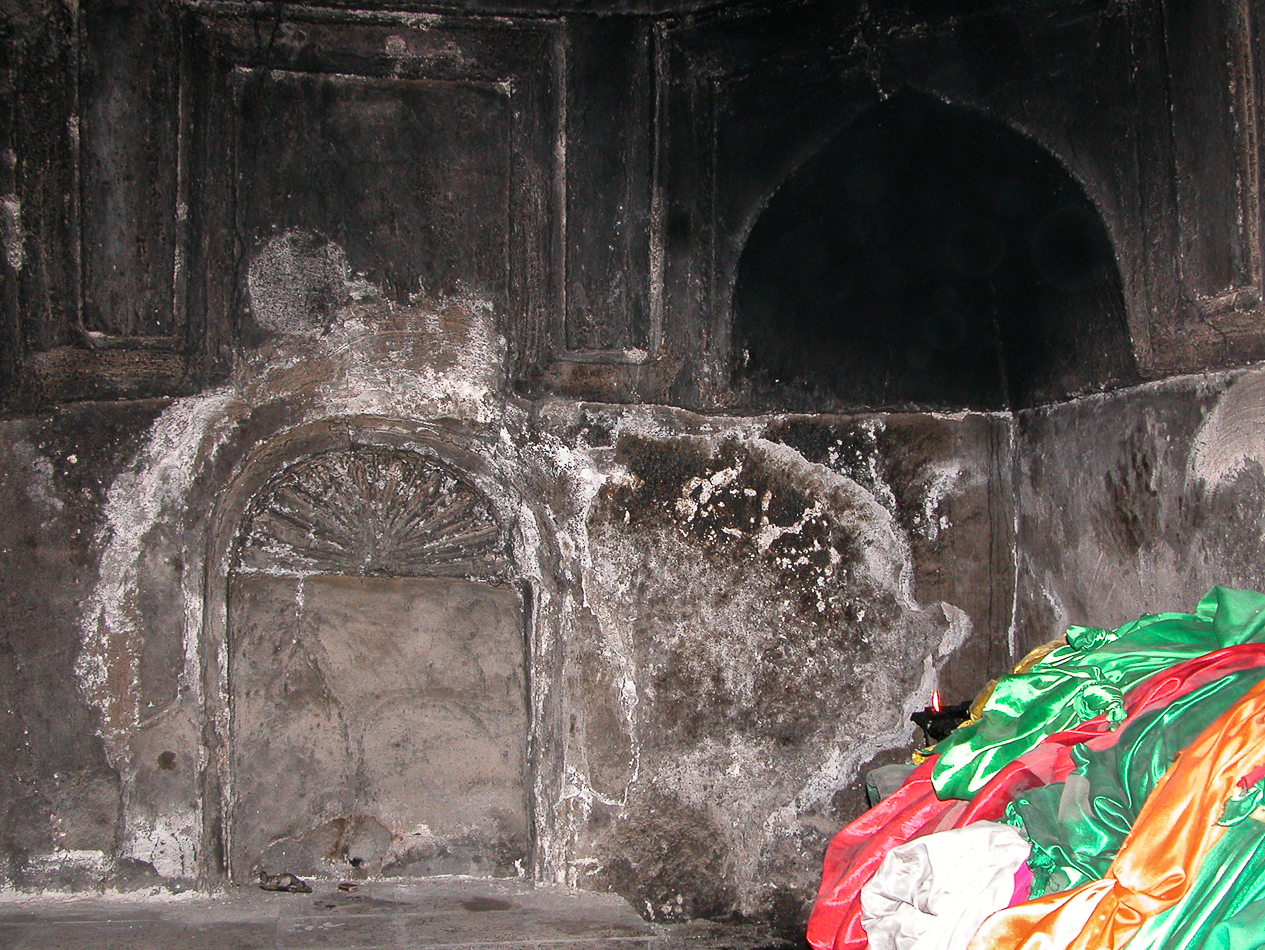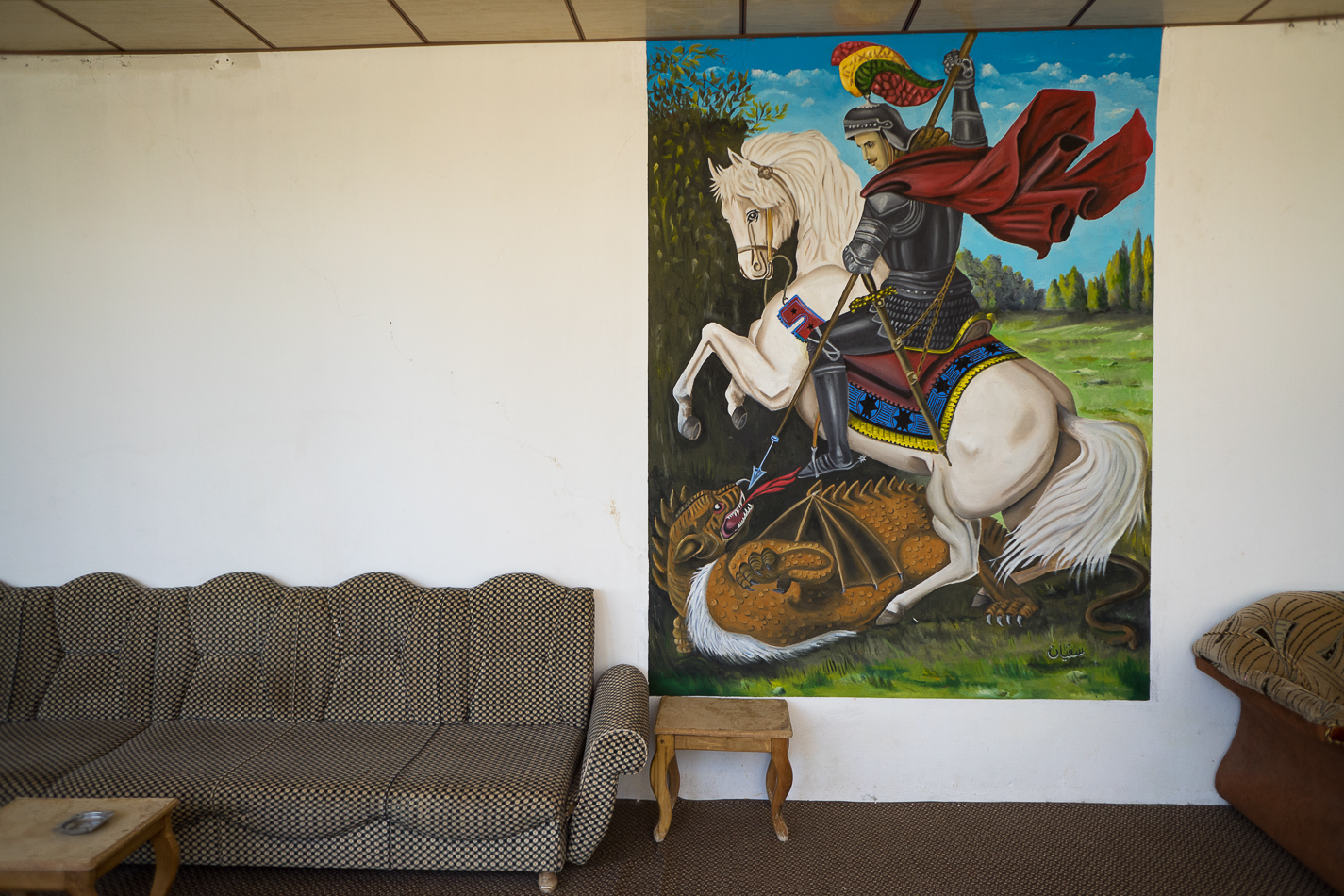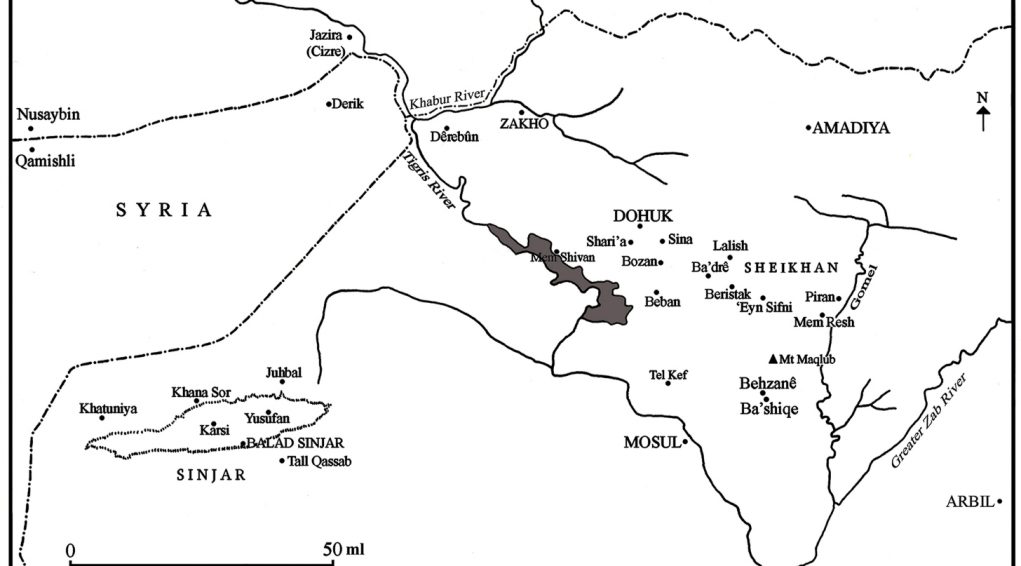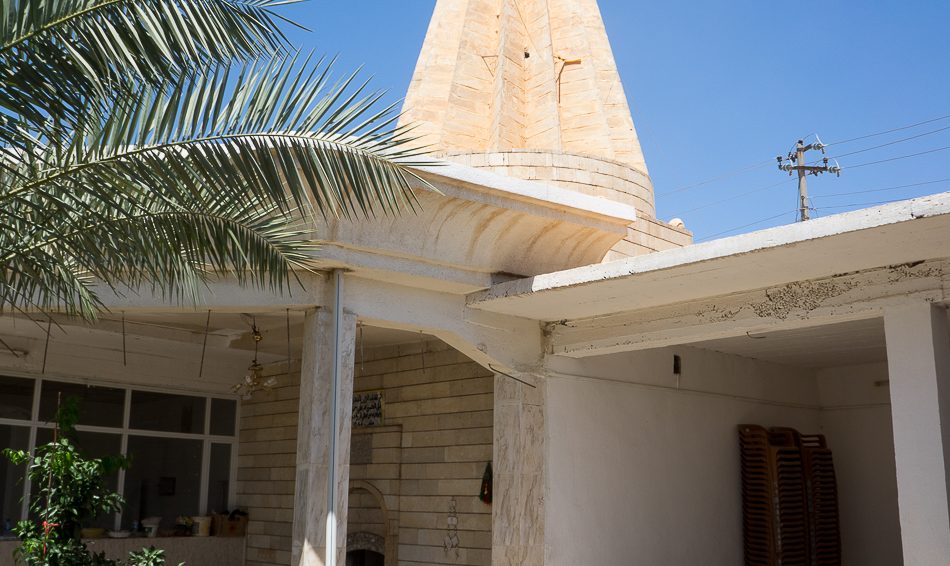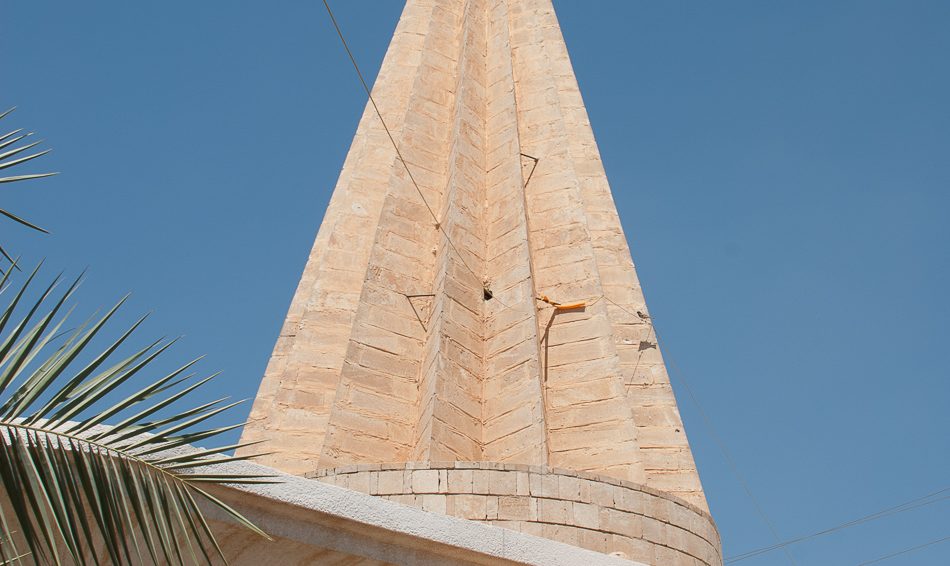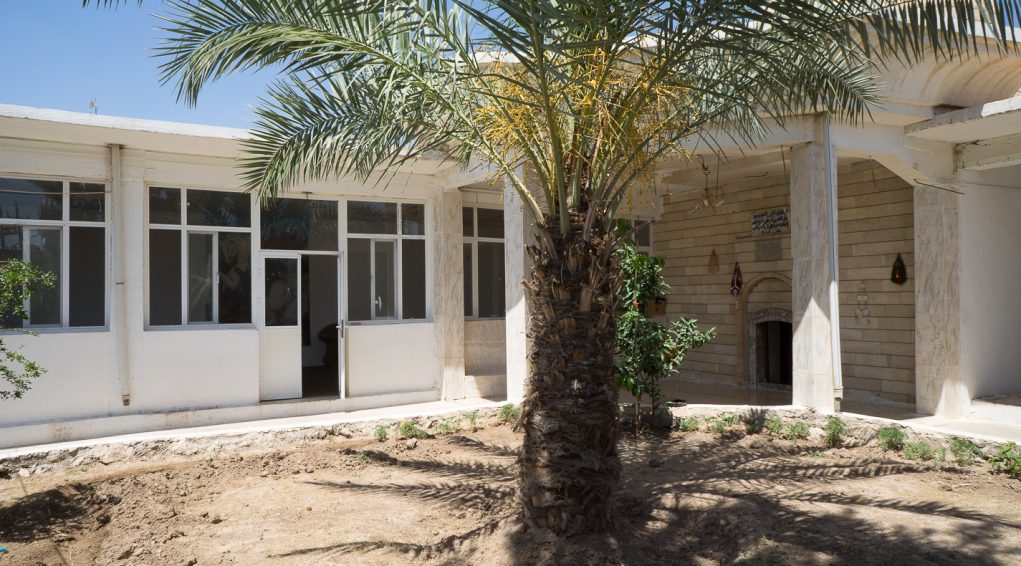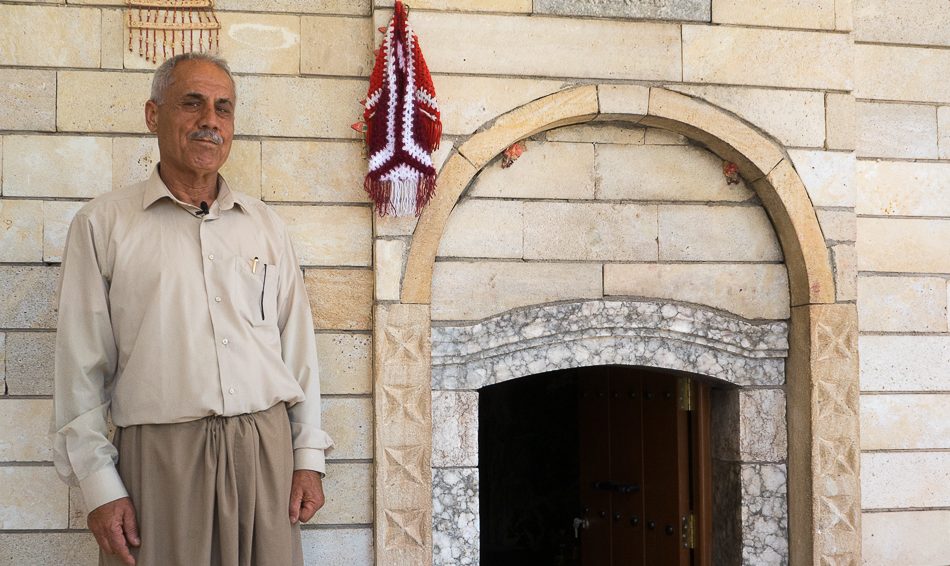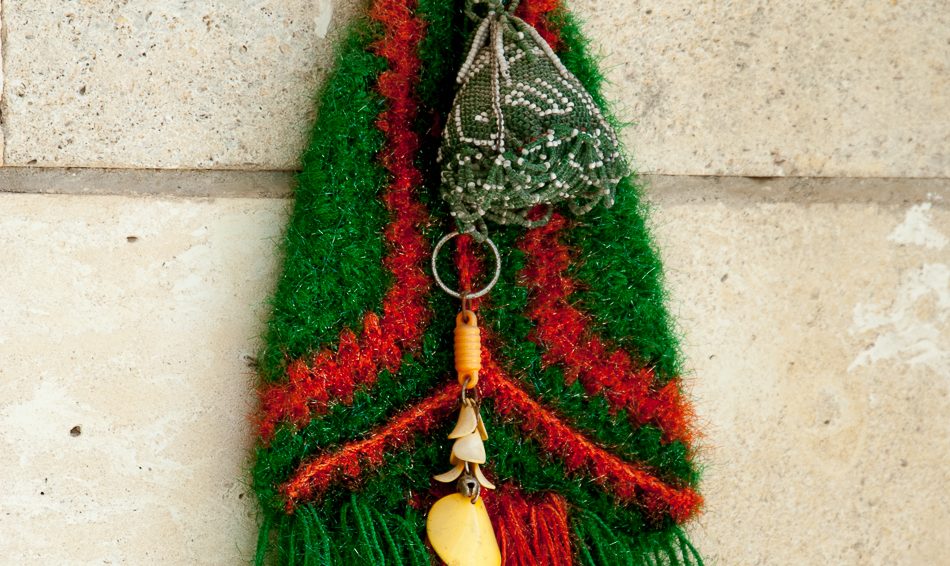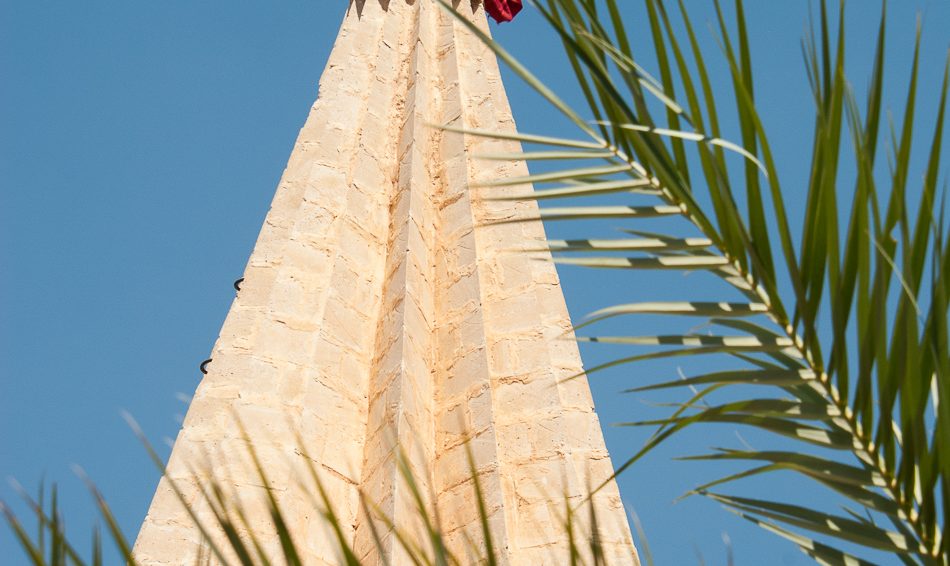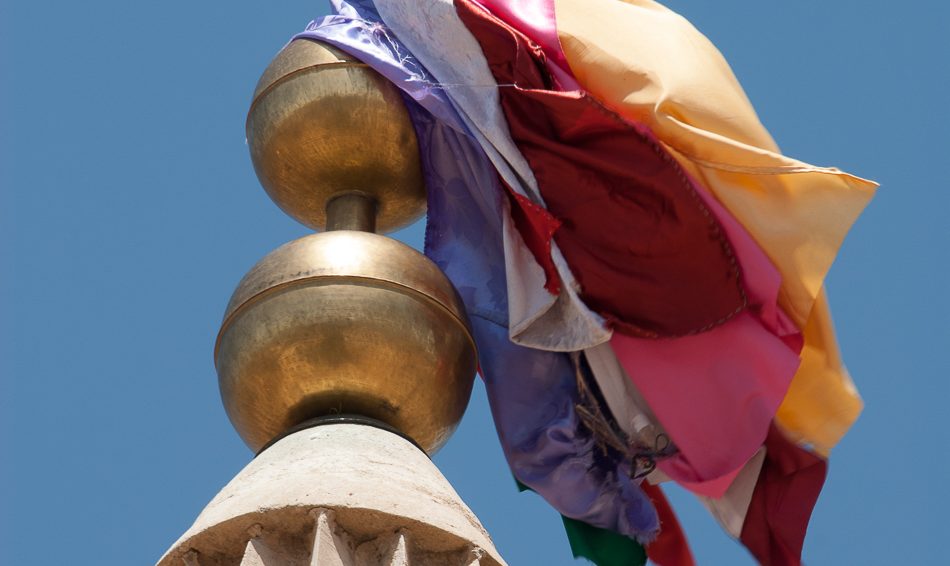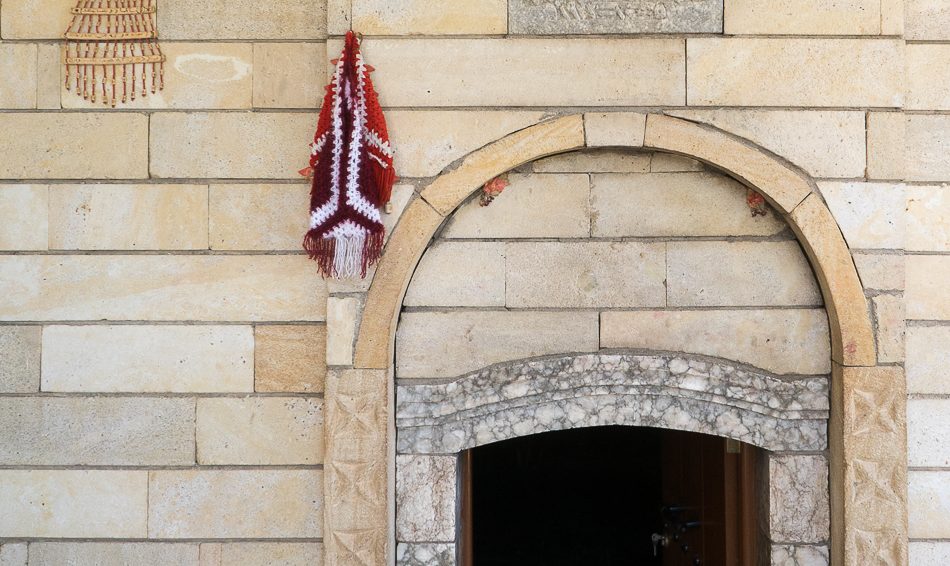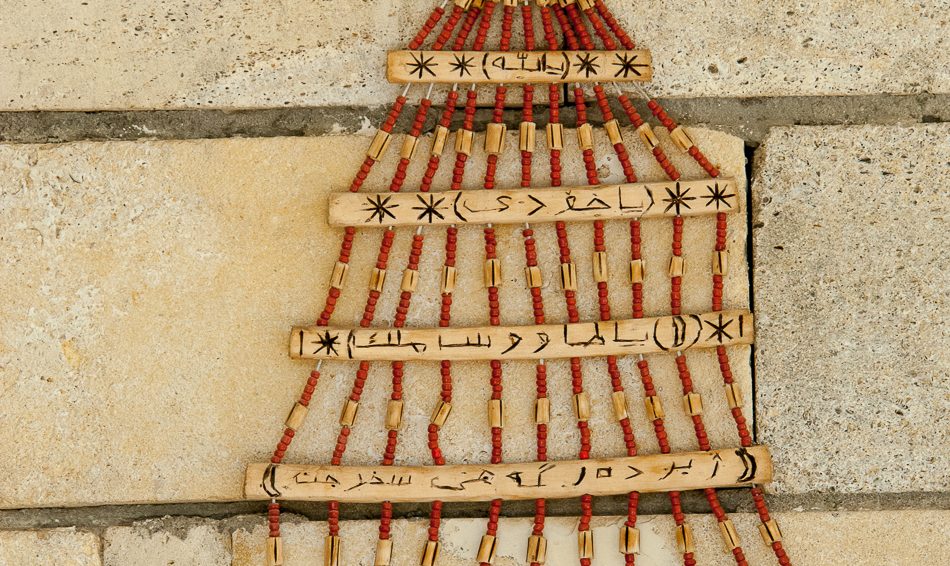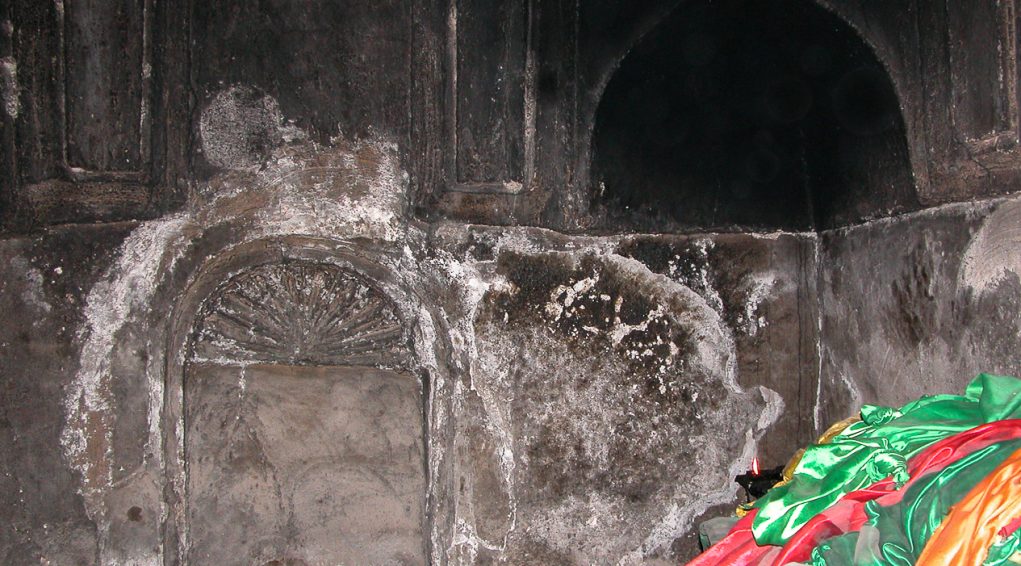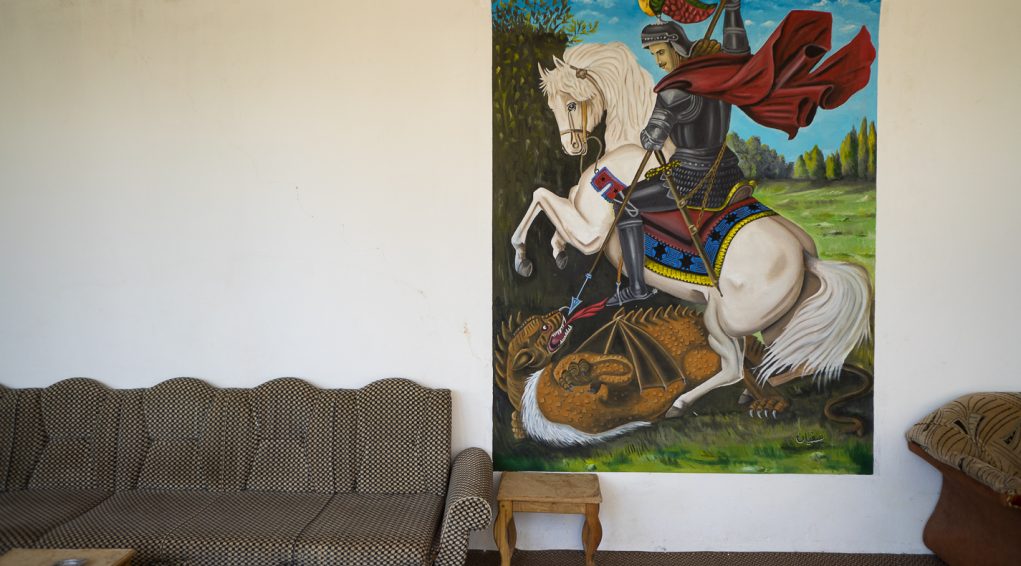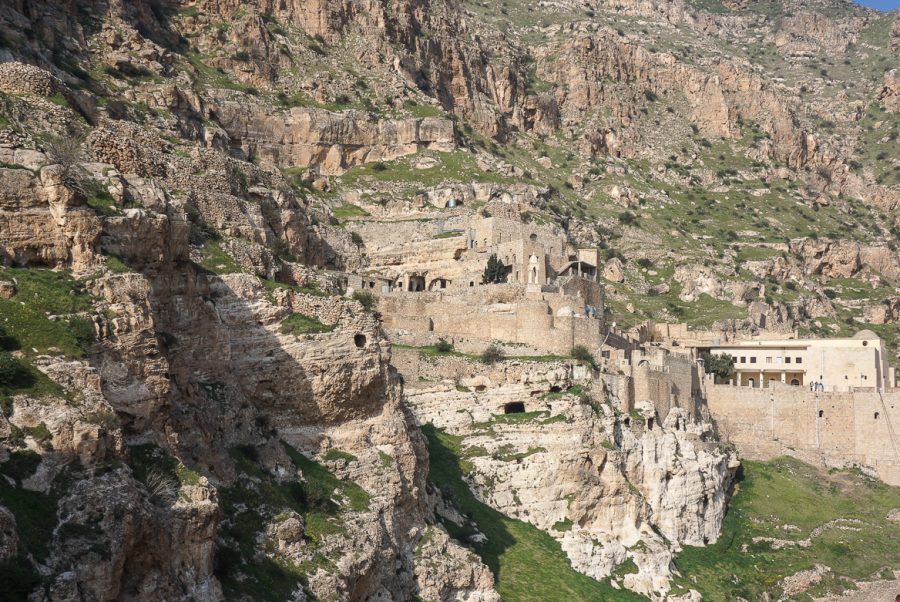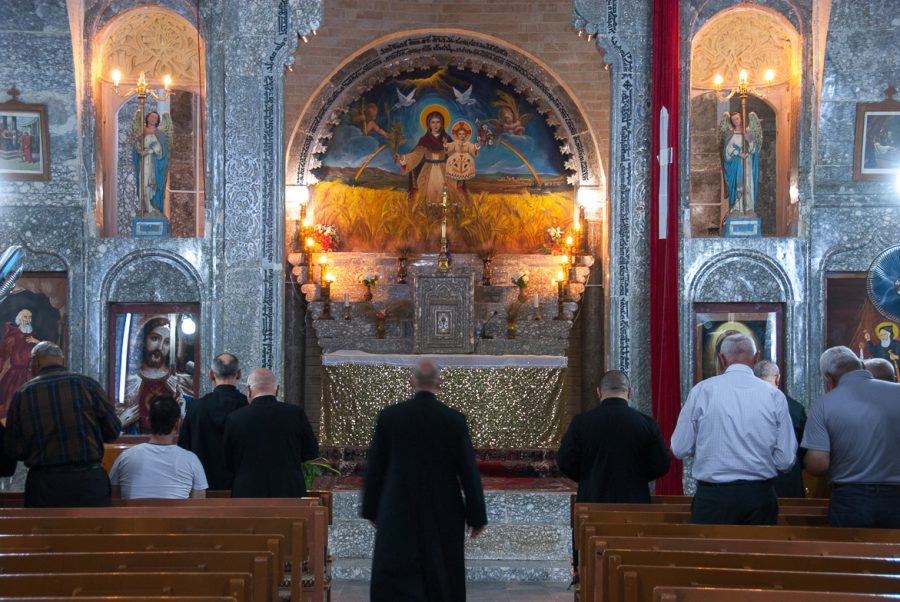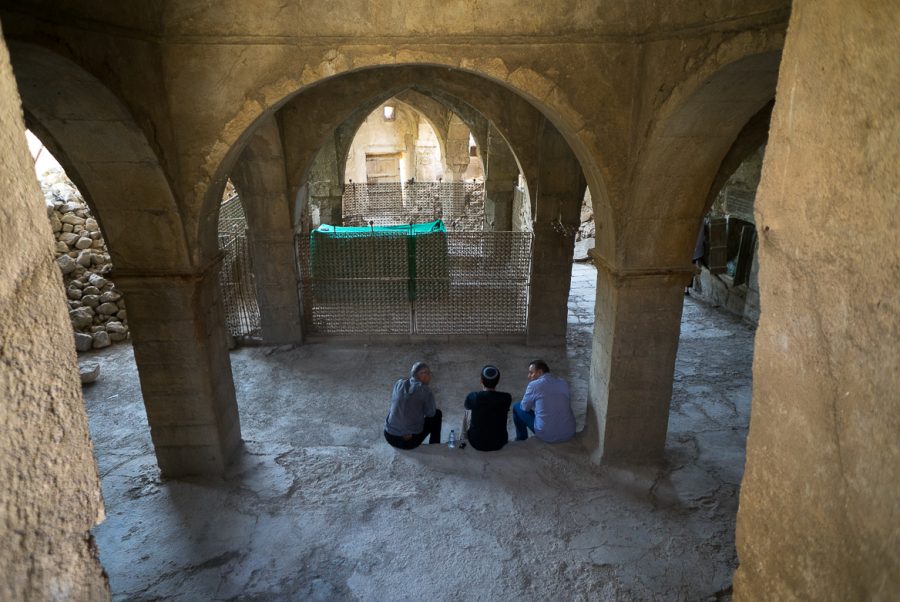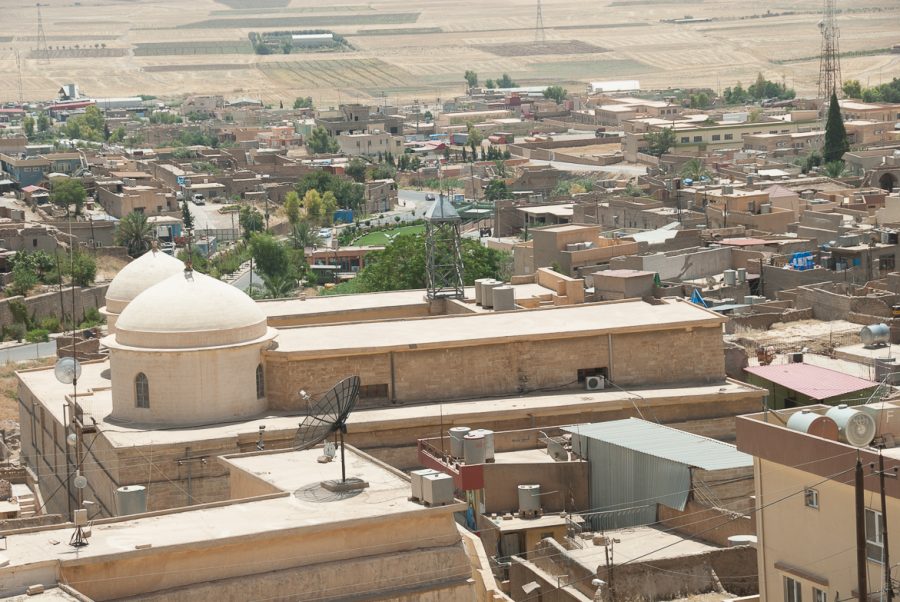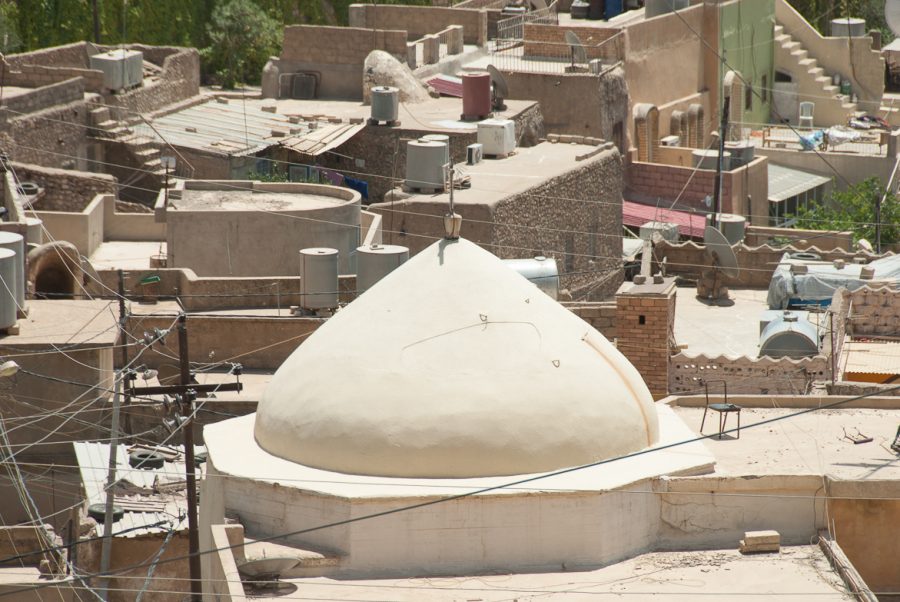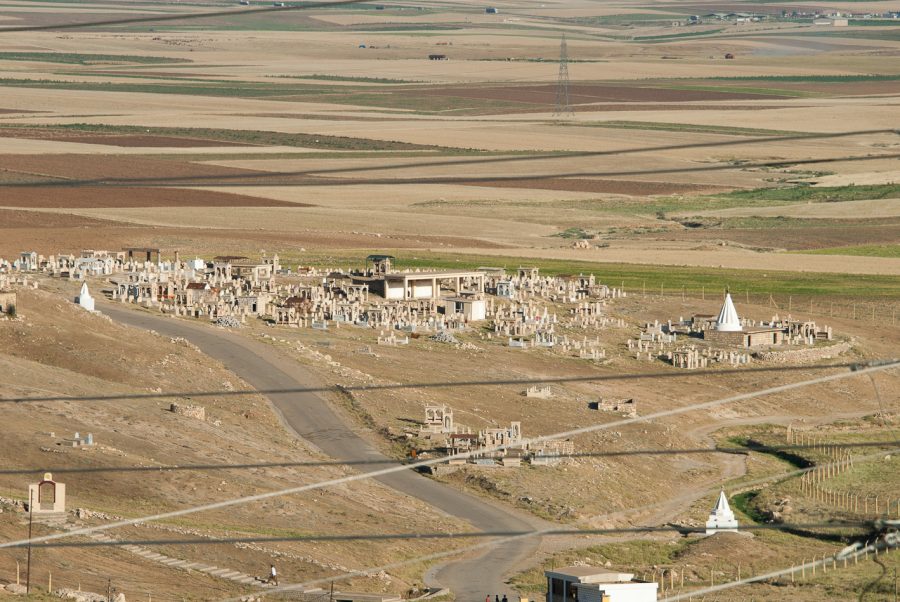Yazidi mausoleum Sheikh Suwar in Beban
The Yazidi mausoleum Sheikh Suwar in Beban is located at 36°42’5.82″N 43° 9’13.56″E and 455 metres altitude in the Nineveh province, close to the major Christian city of Alqosh.
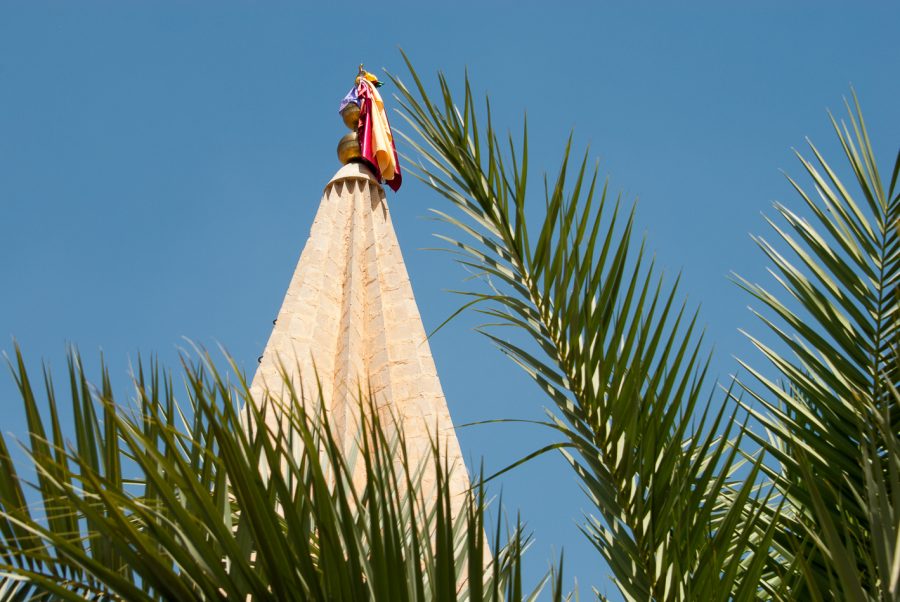
The mausoleum of Sheikh (Shah) Suwar is situated in the centre of the village of Beban, in an interior courtyard with a garden, galleries and arcades. The inhabitants of Beban do not know exactly who Sheikh Suwar was but they worship him with a fervour passed down through generations. This mausoleum was destroyed in 1893 then transformed into a mosque before becoming a Yazidi place of worship once again.
The Sheikh Suwar mausoleum is the only Yazidi building with geometric patterns on the inside surface of its dome and drum. When compared with other buildings in the same style, the mausoleum Sheikh Suwar can be dated to the 14thcentury.
PICTURE : The Yazidi mausoleum of Sheikh Suwar in Beban © Dr. Birgül Açıkyıldız-Şengül, universities of Oxford and Montpellier III.
Plan of the Yazidi mausoleum of Sheikh Suwar in Beban © Dr. Birgül Açıkyıldız-Şengül, universities of Oxford and Montpellier III.
About this file
The content of this file has been drafted by Dr. Birgül Açıkyıldız-Şengül, art historian, specialised in Yazidi heritage and culture. Dr. Birgül Açıkyıldız-Şengül is an associate researcher at the University Paul Valéry Montpellier III and the IFEA Istanbul, and is the author of a doctoral thesis: “Yazidi heritage: Funeral architecture and sculptures in Iraq, Turkey and Armenia” presented in 2006 at the University Paris I Panthéon-Sorbonne (department of Islamic art and archaeology). This thesis contains a documented inventory of 88 monuments (sanctuaries, mausoleums, baptistries, oratories, caravanserai, bridges and caves) and 60 funeral sculptures (in the shape of horses, rams, sheep or lions) in northern Iraq, Turkey and Armenia. Thesis published by I.B.Tauris (London, New York), 2010. The text has been enriched with the observations and interviews of the Mesopotamia team (Pascal Maguesyan, Shahad al Khouri, Sibylle Delaître (KTO)) with support from Mero Khudeada.
Location
The Yazidi mausoleum Sheikh Suwar in Beban is located at 36°42’5.82″N 43° 9’13.56″E and 455 metres altitude in the Nineveh province.[1]
The village of Beben is located 8 km to the south-east of the major Christian city Alqosh, 55 km to the north of the metropole of Mosul and 32 km to the south-west of the Yazidi spiritual centre in Lalish.
Beban is one of the Yazidi villages in the district of Shekhan, a major administrative and spiritual centre which contains the most ancient heritage site of the Yazidi community.
________
[1]The mausoleum is also known locally as Shah Suwar. For the purposes of this file we will use the name employed by Dr. BirgülAçıkyıldız-Şengül, art historian and specialist in Yazidi heritage and culture.
About the Yazidi in Iraq
Mainly settled in the autonomous region of Iraqi Kurdistan and the Nineveh plain, their geographic birthplace, there are also Yazidi in Turkey, Syria, and the Caucasus in particular in Armenia and Georgia. Generally considered as non-Islamic Kurds, which is at the very a least a simplistic if not inaccurate statement given their mythological origins, often demonised due to their religious practices, the Yazidi are a community whose historical origins and number are difficult to estimate.
Marginalized to the extreme in Iraq under various regimes, their existence was practically denied. Prior to 2003, Baghdad officially only recognised a few thousand whereas the reality was no doubt closer to hundreds of thousands.
The conditions for an attempted genocide were already in place even before the ISIS jihadis started to massacre and kidnap Yazidi in the Sinjar mountains and province of Nineveh in August 2014.
Although the Iraqi forces and the coalition of resistance groups took back Sinjar in November 2015, the majority of the 500,000 – 600,000 Iraqi Yazidi are still displaced. The persecution they have suffered makes them fear for the future despite the constitutional guarantees afforded to them in 2005.
The territorial roots of Yazidism
Yazidism was founded in a mountainous territory where its inhabitants were protected by the slopes, peaks and caves. Considered sacred by the Yazidi, this territory roughly divides into two distinct regions, east and west of the Tigris, the key Mesopotamian river. To the west is Sinjar: the city, surrounding villages and the mountain range. To the east is the spiritual centre of Lalish, and the key sectors of Shekhan, Bozan, Bashiqa and Bahzani. The vast majority of the Yazidi population (including clergy) are from these regions although there are some scattered Yazidi communities outside of these areas.
For centuries, the Yazidi have preserved their customs and traditions in this region, this territory. This preservation of the past was cruelly undermined to the west of the Tigris in the Sinjar region by the devastating ISIS offensive in August 2014. The extent of the destruction and severity of the genocidal crimes committed severely weakened the Yazidi communities in the Sinjar mountains who previously formed the core of the Iraqi Yazidi population.
Territory, history and heritage
It is in this region, either side of the Tigris, that the Yazidi were able to preserve and develop the characteristic architectural features of their religious buildings which are the main places of worship for the Yazidi faithful.
These buildings are mostly dedicated to the first disciples of the 12th century Yazidi reformer, Sheikh ‘Adî, members of the Chamsani families and families such as Hasan Maman, Memê Rech and Cerwan, as well as the community’s first religious leaders, descendants of Sheikh ‘Adî (members of the Adani family) and certain important Sufi mystics who influenced Sheikh ‘Adî’s teachings, namely Abd al-Qadîr al-Jilani, al-Hallaj et Qedib al-Ban (Qadî Bilban).
However, it would be wrong to conclude that Yazidism is a medieval religion. The paucity of the theological and historical sources available is compensated for by the ancient tradition and mythology which are omnipresent and constantly developing. The Yazidi consider Noah to be one of their most ancient and most illustrious patriarchs. They even claim that he lived in Iraqi Mesopotamia, in Ain Sifni (Shekhan) where he built his ark. The Yazidi historians claim that “the Yazidi religion is very ancient. It goes back to 3,500 years BC.”[1]
The Yazidi have a wide diversity of places of worship and prayer, including cemeteries, mausoleums (mazar) some of which are larger than others (khas / mêr), fire oratories (nîshan), the houses of Sheikhor Pîr, trees, bushes, olive groves, bridges, arches, caves, sacred stones (kevir), springs etc. These monuments, structure and sites dedicated to the Yazidi “saints” constitute a large proportion of the cultural setting of the Yazidi communities and are the tangible, physical manifestation of the Yazidi belief system as a whole.
There is however, one fundamental place which all Yazidi turn to, including the diaspora: the Lalish valley in Iraqi Kurdistan. It is the most sacred place in Yazidism. It is the location of the sanctuary of Sheikh ‘Adî, the great reformer of Yazidism in the 12th century. This valley, its mausoleums and its environment are the centre of gravity of Yazidi spiritual life.
The Yazidi buildings were built at different times. The lack of inscriptions and historical sources make it difficult to date them accurately. The poor quality of some of the more recent restorations makes this analysis even more complex. Furthermore, there do not seem to be specific architectural styles associated with specific periods of Yazidi history which could help to date these buildings. In addition, the same style, derived from a specific model has been used at several times over the centuries and is still in vogue.
________
[1] Chamo Kassem, inspector of Yazidi schools, specialist in Yazidi religion and culture, Head of Culture and Media, at the Lalish Cultural and Social Centre in Dohuk-Nohadra.
Fragments of Yazidi spirituality and theology
Yazidism is a religion based on tradition and oral history that is both simple and complex at the same time. Simple, because it is not regulated by a constraining liturgy or dogma. Complex, because there is no fundamental theological document underpinning it such as the Torah, the Gospels or the Koran. The Yazidi have two sacred books: the book of revelation “Kitêb-i Cilvê “, and the black book “Mishefa Reş”.
Yazidism is a strictly community-based religion (national). One is born Yazidi, you cannot become Yazidi. There is no evangelizing, inculturation or proselytizing. That said, Yazidism is not sectarian. Quite the opposite, altruism is considered to be a cardinal virtue, a spiritual and theological foundation. Any researchers interested in studying Yazidism are therefore warmly welcomed by the community and its clergy.[1]
Yazidism is a monotheism. God is singular and unique. He is the creator of the cosmos and of life. In this, Yazidism shares the same belief as the three main monotheist religions: Judaism, Christianity and Islam. As well as Zoroastrianism.[2]
God is light. He is like the sun which shines on the Earth. That is why the Yazidi systematically face the sun to pray. This is something Yazidism shares with Mesopotamian and Persian Zoroastrianism.
God is good, infinitely good. This is why the Yazidi encourage altruism and always pray firstly for the world and then for themselves.
God is everything and is everywhere. Yazidism is physically and spiritually one with the whole of Creation: cosmic, human, animal, vegetal, and mineral. That is why olive trees whose oil is used for the sacred fire are considered sacred by the Yazidi. Similarly, the angel peacock (tawûsê melek) is the most important of the seven angels (melek) which represent God on earth.
Yazidism believes in the judgement of souls and the last judgement. However, it differs from Christianity in its belief in reincarnation. The dead are buried. Their souls are judged according to the good and evil they have done. Pure souls become beings of light. Impure souls are reincarnated in devalued or bellicose human or animal forms.
_______
[1] « Jean-Paul Roux, who passed away in 2009, former CNRS researcher and head of the Islamic art section of the École du Louvre, considered Yazidism as “a standout religion, an obvious syncretism of popular tradition and reminiscences of the dogma of the major religions’’. La Croix, Claire Lesegretain, 26 April 2010.
[2]Born in Persia, founded by Zarathustra (Zoroaster) in the first millenium Before Christ, Zoroastrianism is monotheist and recognises Ahura Mazdâ as the only God. In this sense Zoroastrianism is fundamentally different from the Mazdaism it is derived from. Mazdaism is polytheist, considering Ahura Mazdâ as the main, but not the only, God. This Persian religion spread as far as India in the form of Vedism.
Yazidi worship
Yazidi worship is not governed by a strict liturgy but constitutes a set of traditional rites and votive practices passed on orally from generation to generation.
The Yazidi generally pray individually, but also gather together as a community at their temples and sanctuaries to listen to qawals, who are both musicians and the gatekeepers and guardians of the Yazidi religion, whose knowledge and practices are passed on from father to son.
The daily prayer, facing the sun, the light of God (Khoda), is not an obligation nor is it required to show you are a “good” Yazidi. However, pious, elderly people pray regularly, up to five times a day.
Kissing sacred places and the hands of saintly figures, offering gifts to consecrated persons, sacrificing animals, knotting and unknotting fabric on wish trees, are all signs of respect and devotion.
Wednesday is the most important day in the week. It is like Sunday for Christians, Saturday for Jews and Friday for Muslims. The main weekly services during which the Yazidi monks light the sacred fire in the mausoleums are held on Wednesdays.
Four major annual festivals are held during the Yazidi religious year. The first is the New Year (ser sal) celebrated on the first Wednesday of the month of April. This festival symbolises the creation of life out of the initial chaos and the coming of tawûsê melek. Eggs, a symbol of the original lifeless earth, are boiled and dyed as part of the celebrations. Some of these eggs are smashed above the doors of houses and mausoleums, mixed in with small red flowers.
Another major annual festival is the Spring festival (towaf), which is held on a date between 12th – 20th April. Finally, the pilgrimage to the tomb of Sheikh Adî, in the Lalish sanctuary (djamaiya) takes place on 6th October.
The mausoleum with a conical dome: characteristic Yazidi architecture
Mausoleums with a conical, striped dome are emblematic of Yazidi sacred art. Extremely sober in terms of its architecture and decoration, this type of building is built on a cube structure which contains the tomb or cenotaph, covered by a slab with a drum above which stands a conical dome composed of multiple crests. This vault symbolises the sun’s rays which light up the earth and humanity.
The pinnacle of the dome is systematically fitted with a bronze spire formed of one or more spheres, mounted with a ring, a crescent moon, and a celestial body or hand, around which swathes of coloured fabric are knotted. The spire represents the cosmos, the planets, the sun and the stars created by God. The coloured fabrics represented the colours of the rainbow. [1]
The interior of a Yazidi mausoleum is often composed of a separate chamber containing a sarcophagus covered in silk fabrics. There are also often several niches carved into the walls to burn incense and light the sacred fire. These often also contain knotted fabrics placed there by pilgrims making wishes.
The sacred space in any Yazidi mausoleum includes the slab in front and around it. That is why any visitor or pilgrim must remove their shoes.
________
[1]This interpretation can vary from one community to another.
Recent history and Yazidi demography in Beban
Beban, part of the Shekhan district, is an exclusively Yazidi village.
The economic activity is primarily agricultural, dominated by livestock farming. According to the inhabitants the infrastructure is in a very poor state. In addition to problems with the water and electricity supply there are also severe sanitary issues. There are no healthcare facilities in Beban.
The village of Beban, like many other Yazidi villages in the Nineveh province, was evacuated in haste on 9th August 2014, due to the progression of the ISIS offensive. Fortunately, Beban was not invaded. The villagers returned progressively over a period of several month but many have still not come back.
In 2014, before ISIS there were 2,000 inhabitants in Beban. Despite the military defeat of the Islamist organisation at the end of 2016, 1,000 inhabitants returned to Beban in June 2018.
Beban is home to two sacred Yazidi mausoleums: the largest is the mausoleum of Sheikh Suwar. The second is that of Melik Sheikh Sîn. [1]
_______
[1]The mausoleum is also known locally as Fakhral-Dîn.
The Yazidi mausoleum Sheikh Suwar in Beban:
The mausoleum of Sheikh (Shah) Suwar is situated in the centre of the village of Beban, in an interior courtyard with a garden, galleries and arcades.
The inhabitants of Beban do not know exactly who Sheikh Suwar was but they worship him with a fervour passed down through generations. When they open the door to the mausoleum and kiss the threshold, the Yazidi say the following prayer: “Oh Shah Suwar, pray for us, protect us from evil.” According to Pr. Philipp G. Kreyenbroek, Sheikh Suwar is the lord of war and the cavalry.[1]
Although there are two epigraphs in Arabic inscribed on the monument, they do not refer to the date of construction. The Yazidi representatives in Beban know that this mausoleum was destroyed in 1893 then transformed into a mosque before becoming a Yazidi place of worship once again. An ancient inscription engraved on a marble slab just above the entrance door refers to a restoration in 1922. Just above this, on a second marble plaque, an inscription states that the mausoleum was restored in 1985. This plaque also provides the names of the contributors.[2]
The mausoleum is a small cubic metre measuring 3.5 metres by 3.5 metres. A low, vaulted door in the west wall provides access to the interior. The square tomb chamber is covered in an elevated hemispherical dome. Inside the structure, the north and east walls are hollowed out with a niche with round arcades. There are two cenotaphs in front of the south wall. On the outside, the conical, crenelated dome is mounted on a drum with two levels, one octagonal, one circular.
The Sheikh Suwar mausoleum is the only Yazidi building with geometric patterns on the inside surface of its dome and drum, as well as two superficial niches in the walls. The decoration is applied to the mortar. The hemisphere of niches has ten fine ribs radiating out from the centre which give it the appearance of a shell. The surface of the dome is decorated with an eleven-sided star. The star is formed at the crossing point of the branches which radiate in different directions from a central point. Between these different branches, small and large closed polygons form with an eight-petal flower in the centre. The surface of the circular level of the drum is marked with a frieze showing eleven basket handle arches mounted on blinds, whilst on each side of the octagonal drum is marked with a meandering patterned frieze which frames the squinches in the round arch.[3]
The decoration on the surface of the dome is part of the continuity of a tradition which started with the mausoleum of Sultan Sandjar in Merv (1157) in Turkmenistan, and continued in Anatolia with the gate to the Mosque of Huant Hatun in Kayseri (13th century) and in Iraq the mausoleum of Imam Yahya Abû’l Qasim in Mosul, dated from the 14th century. The same decor finds its correspondence in the brick applied to the surface of the dome in the Mosque of Sultan Sulaymaniyah in Hisn Keyfe in Turkey, dated from the end of the 14th century and to the middle of the 15th century. However, the surface of the dome of this mosque is decorated with a sixteen-sided star. The shell-shaped niche is also visible from the Süleymaniye Mosque and the mausoleum of the imam ‘Avnal-Din in Mosul. Furthermore, the basket-handle arches are often represented on the facades of 14th century mausoleums in Ahlat and Gevash on lake Van in Anatolia. This comparative evidence dates the mausoleum of Sheikh Suwar to the 14th century.[4]
It should also be noted that there is a large diwan on the north-west side of the mausoleum, on the wall of which is painted a large mural of Saint Georges killing the dragon. An emblematic figure in Eastern Christianity, Saint Georges is prayed to by the Yazidi.
________
[1]This reference needs checking and completing. Indeed, Sheikh (Shah) Suwar would appear to have been the head of the Turkmen dynasty of the Dulkadir in Anatolia. However, the mausoleum of Sheikh (Shah) Suwar has been dated back to the 14th century by Dr. Birgül Açıkyıldız-Şengül. There would appear to be a historical inconsistency.
[2]And not in 1923 as indicatd by Dr. Birgül Açıkyıldız-Şengül.
[3]Where are these friezes? They are not shown in the photos taken.
[4]Merv is today known as Mary. The city which was already very well known in antiquity was the seat of the Persian Satrap of Margiana. Conquered and refounded by Alexander the Great it was renamed Alexandria in Margiana. The city was also an important religious centre for the Church of the East from the 6th century onwards. Hisn Kayfa corresponds to the city of Hasankeyf in the province of Batman in the south-east Turkey. The city was partially built on the cliff above the Tigris which explains its original Syriac name: Hesn Keyfo which means the citadel of stones. The city and its archeological remains are under threat of being swallowed up with the construction and creation of the resevoir by the Ilisu dam in 2019. This region goes by the name of the Armenian plateau is situated in the far east of Turkey.
Monument's gallery
Monuments
Nearby
Help us preserve the monuments' memory
Family pictures, videos, records, share your documents to make the site live!
I contribute